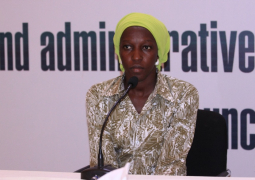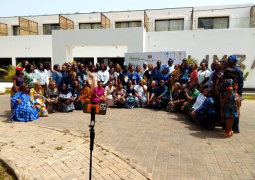The day provides a platform to raise public knowledge and awareness on DRR and its attendant risks and challenges, and for stakeholders to discuss strategies for the effective empowerment of children and youth in disaster management. Also to provide them with the tools to create a Gambia that is well-prepared to counter disasters and the attendant issues that come with climate change.
Cognisant of the role of children and youth as change-makers in their communities, in 2006, UNDRR launched a campaign “Disaster Risk Reduction Begins at Schools” to promote the teaching of hazards and risk reduction in schools to improve school safety. Allowing children and youth to lead initiatives for disaster mitigation enables them to build their leadership skills and take ownership of a resilient future. In The Gambia, however, most of the DRR plans and programmes mainly target adults and greatly marginalise children who are seen as passive victims with limited roles in DRR.[1].
Disaster risk reduction interventions and policies should have children and youth at the center. This is crucial as disaster events are increasing and the number of children affected is rising. As of September 2024, a population of 19,271 were affected out of which 5,587 were children. 2,968 males and 2,619 females. In 2023, 32,463 children were affected, comprising 16,606 males and 15,850 females. In 2022, 10,780 children were affected, with 11 deaths including children. 1.85 million children were affected by climate disasters in the Sub-Sahara countries[2] and COVID-19 increased the threats to the future of 55 million children under the age of 18 years[3]. The Gambia is not exceptional. In 2010, the country registered 13 deaths[4] as a result of flooding and in 1995, 2005, 2006, 2007 and 2010 floods in KMC, WCR and CRR led to serious cholera outbreaks which resulted in the death of children.[5] Considering the Gambia’s population of two million (according to the 2013 Population and Housing Census), the number of deaths is significantly high.
According to the Gambia Bureau of Statistics (GBoS) 2024 Population and Housing Census Preliminary Report, the Gambia’s population is 2.5 million, of which 51% are females and 49% are males. Conversely, the country's population is predominantly youth, with 40.8% under 15 years. Comparing 2013 to 2024, the population under the age of 15 years rose from 792,065 to 988,383 with an increase of 24.8%. The cohort of this population is always vulnerable and exposed to disaster hazards and at the same time “are resources that need to be mobilised and nurtured to enhance disaster preparedness for resilience for present and future”[6]. It is our collective efforts to enhance their education, knowledge and awareness and hone their skills in innovative approaches to disasters and hazards prevention, mitigation and management so that in their social mobilisation and advocacy initiatives they can reach out to more people and communities and reduce the risks of disasters.
As the trend of disasters continues to cause more negative impacts on the environment, humans, animals and biodiversity, future leaders should be well prepared and empowered for any unforeseen eventualities affecting their lives and livelihood for the sustainable development of their communities and cities as envisaged by the SDGs and the Sendai Framework for Action whose goal reemphasises the slogan “Words into Action” (WiA) 2015-2030.
Thus, the active participation of children and youth in decision-making platforms is very relevant as international human rights and gender equality provide for their right to protection from disasters. When children and youth take center stage in DRR efforts, The Gambia will be fulfilling its obligations under regional and international legal instruments such as the Universal Declaration of Human Rights, the African Charter on Human and Peoples' Rights, the UN Convention on the Rights of the Child (CRC, CEDAW and the Maputo Protocol). It would also propel household preparedness and resilient building.
The National Contingency Plan 2021-2025, identified four recurrent hazards in the Gambia, ranking accordingly; flood, windstorm, epidemic, fire outbreak and drought. These hazards disproportionately affect children and youth, negatively impact their education nutrition, mental and physical health, and lives, and expose them to displacement, violence as well as many other limiting factors. Children and youth who live in poverty are especially more vulnerable to the negative impacts of the hazards. Nonetheless, these children and youth have the right to DRR knowledge and the DRR players must protect and fulfil their fundamental human rights and freedoms. Training children and youth on DRR participatory measures to empower children-youth and ensure they are actively involved and contribute to making their cities and communities resilient to disasters saving their lives and communities. Non-fulfilling the fundamental human rights of children and youth can adversely affect their future growth and survival, and expose them to the risks and hazards from the growing intensity and recurrence of disasters. The Hyogo Framework for Action, the Sendai Framework for DRR and the domestic, regional and international legal frameworks provide the blueprint for the promotion of an inclusive approach to disaster risk reduction.
The potentials and contributions of children and youth are often not considered in the building of resilient environments and are not often listened to or included in decision-making that reduces disaster risks and builds resilience[7].Children and youth have the right to acquire the right knowledge and to think critically about risks surrounding them; provided the skills for disaster preparedness, response, recovery and mitigation; and empowered to make informed decisions to protect themselves and their communities against present and future risks. As knowledge is power, we should prepare children and youth to effectively engage in decision-making and as architects for risk-sensitive policies and strategies which would determine the future of their communities.
For their needs to be met and contributions incorporated in disaster risk reduction work, collaborating and partnering with children and youth is significant if our approach to disaster management is to be all-inclusive.
Disaster Risk Reduction requires proactive application of the 4Rs concept of Readiness, Response, Recovery and Reduction. As a critical mass and to capitalise on their demographic dividend, children and young people should be active in the realisation of the 4Rs. In addition, the UN Decade of Education for Sustainable Development has four fundamental values, two of which are linked to DRR which mentioned “respect for the human rights of future generations and a commitment to intergenerational responsibility” and “respect and care for the greater community of life in all its diversity”.
As a country that is experiencing the effects of climate change and with communities that are prone to disasters and hazards, every effort should be taken to adequately prepare and engage the children and young people as advocates for and architects of risk-sensitive policies, strategies and programming that will shape future societies and a resilience Gambia, based on bottom-up to top-down approach and from “business as usual to business unusual”. Rather than us making decisions on their behalf, allow children and youth to make their own decisions about disaster risk reduction.
Empowering the next generation for a resilient future is our collective responsibility. Through collaboration, engagement, and participation, we can build resilience for adaptation and mitigation of disasters.
[1] Tom Mitchell1, T. T., & Haynes2, & K. Children as agents of change for Disaster Risk Reduction: Lessons from El Salvador and the Philippines (No. 1). Brighton.
[2] https://www.euronews.com/green/2023/09/04/climate-disaster-displaced-nearly-2-million-children-in-sub-saharan-africa-last-year
[3] https://www.unicef.org/media/96356/file/Sub-Saharan%20Africa%20%E2%80%93%20Growing%20up%20in%20crisis%20in%20a%20world%20of%20opportunities%20.pdf
[4] https://reliefweb.int/report/gambia/supporting-community-actions-disaster-reduction-flooding-along-gambia-river
[5] Multi-Hazard Profile of The Gambia 2022-2024
[6] Betty Pfefferbaum, R. L. P. & R. L. V. H. (2018). Involving children in disaster risk reduction: the importance of
participation. European Journal of Psychotraumatology, 9:Sup2, 1425577,
https://doi.org/10.1080/20008198.2018.1425577
[7] UNISDR. (2015). CHILDREN & YOUTH FORUM. UN World Conference on DRR. Sendai, Japan.
Read Other Articles In Headlines




